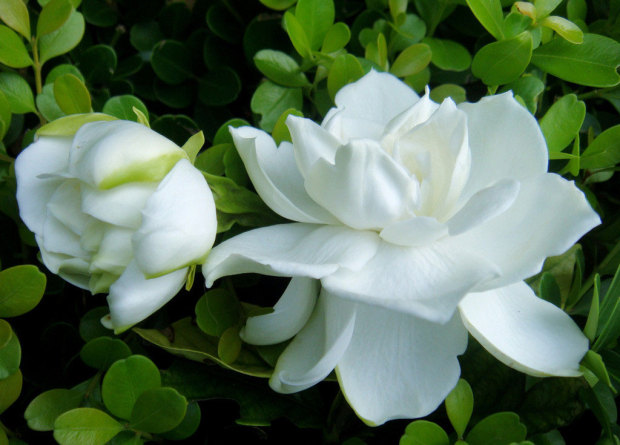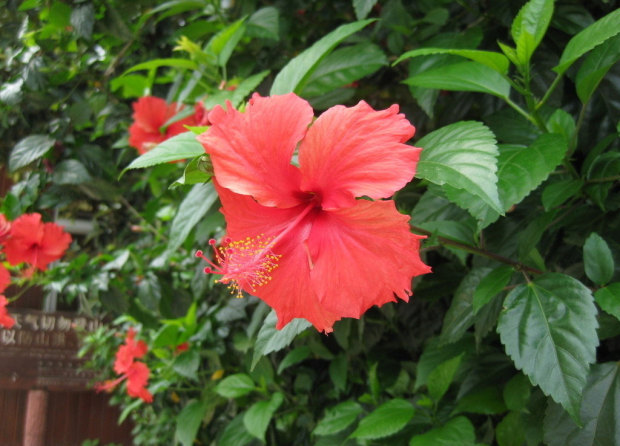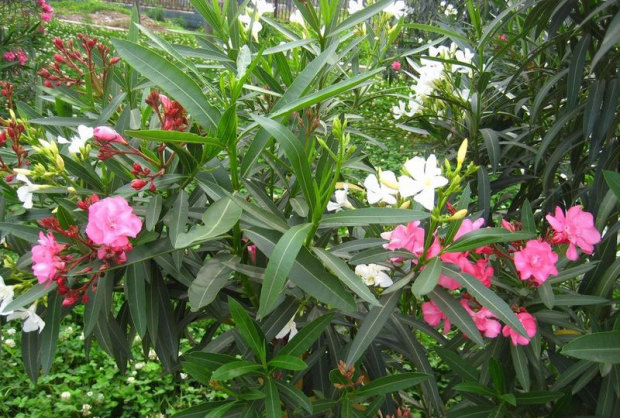Cultivation and Culture methods of Gardenia jasminoides
Gardenia is an evergreen shrub with emerald green leaves, leathery gloss, Corolla milky white six-valved, solitary branchlet tip, fragrant; after withering, it becomes yellowish brown, and the afterscent is still overflowing; the florescence is April or June. Gardenia is one of the most popular garden and potted ornamental flowers. I it is more famous for its large flower double variety, and gardenia with macula on its leaves is very rare. Gardenia is native to southern and central China, mostly in South and Southwest China, and also in Japan. Sex likes to be warm and humid and grows on fertile acidic soil. Not resistant to exposure and cold, potted in the north, overwintering indoors in winter. For propagation cuttings, mature and sturdy branches of one year are cut in April and May, cut into 10mur15cm long, with 3 leaves at the top, and inserted in the sand bed. Under the conditions of temperature above 20 degrees and relative humidity above 80%, they can take root in about 40 days. If you dip it in the vitamin B12 injection solution before insertion, take it out and hang it for a minute or two, and then insert it after the solution is sucked into the cuttings, it can shorten the rooting time for about 10 days and improve the rooting rate. The cutting sand bed should be covered with plastic film for heat preservation and moisturization. it can be propagated in a small amount, or soaked in water in a glass; it can also take root at a temperature of 20 degrees, 28 degrees and 40 days. Sowing can also reproduce, and it can be sowed immediately after receiving the seed, but because the seed dormancy period is long, it can only germinate after one more year, and most of the cultivated varieties are not fruitful, so they are rarely used.

Gardenia is cultivated in the open field in the south of the Yangtze River, the management is very extensive, almost anywhere can be planted, but there must be thick soil and moist conditions, the Huaihe River basin should choose a place without alkaline and shelter from the wind to avoid yellowing and freezing damage, open field cultivation, late autumn or early spring should be in the base of fat mud, three or five years later, some old branches are renewed and trimmed. How to prolong the florescence of Gardenia jasminoides? Key points of cultivation and maintenance of Gardenia jasminoides
At the beginning of graduation, gardenia is in full bloom, named because of its fruit like a wine glass, also known as yellow gardenia, flowering from June to August, properly maintained, blooming for as long as February. Gardenia likes a warm, moist and half-yin and half-yang environment, which is suitable for growing on fertile, loose and moist acidic loess. Therefore, the conservation of gardenia, need to do the following work.
1. Cultivation and maintenance
Gardenia should be transplanted with soil, which should be carried out in spring or plum rainy season. the soil should choose fertile, loose and well-drained acid soil, pot planting should use rotten leaf soil plus mountain mud, add a small amount of cake fertilizer and bone powder as base fertilizer, pour water through water after transplanting, put it in a cool place, and carry on normal management after slowing down seedlings.
Pruning and pruning should be carried out in early spring, cutting off the long branches in time, and cutting off the top tips from May to July to promote branching. Cut off the remnants of the flowers after they fade. Hot summer to more watering, sooner or later spray water to the leaf surface, increase humidity, pay attention to shade, do not be exposed to direct sunlight, it is best to put under the shade, or move into the indoor ventilation place.
Spring and autumn can be put in the outdoor sun, before flowering and throughout the growing period, thin fertilizer should be applied once every semimonthly. If yellow leaves are found, 0.1% ferrous sulfate can be used to sprinkle them in water and fertilizer. Late autumn moves indoors to the sunny place to overwinter.
Excessive room temperature and poor ventilation in winter are easy to breed scale insects and bituminous coal disease, which can be sprayed with carbendazim 500-1000 times liquid.
2. Reproduction and maintenance
Gardenia jasminoides can be propagated by cutting, striping, split and other methods.
(1) cutting
The survival rate of cuttage with tender wood is high. Take gardenia twigs as cuttings, 10-15 cm long, leave 2 leaves at the top and cut in half, cut off the rest, insert into the seedbed, shade and moisturize, and take root in about 20 days.
(2) ramet
Dig up the plant with soil, then cut it with a flower pry to the root, and plant it separately, put it in a cool place, and move it to the sun a week later.
(3) pressing strip
Gardenia planted in the ground often use this method. Select 2-3-year-old strong branches, pull down the ground, peel off some bark, press it into the soil, and then cover it with soil, it can take root after a month, and can be separated from the mother plant in mid-and late June, and planted in the next spring.
Cultivation and Management of Gardenia jasminoides (scientific name: Gardenia jasminoides), also known as Gardenia jasminoides, Gardenia jasminoides, Rubiaceae. Mainly distributed in Guizhou, Sichuan, Jiangsu, Zhejiang, Anhui, Jiangxi, Guangdong, Yunnan, Fujian, Taiwan, Hunan, Hubei and other places. Like warm and humid, sunny, cold-resistant, semi-overcast, afraid of stagnant water, requires loose, fertile and acidic sandy loam, prone to yellowing of leaves, originated in China. Belonging to Rubiaceae, it is an evergreen shrub with luxuriant branches and leaves, evergreen leaves and fragrant flowers. It is an important garden ornamental plant. In addition to ornamental, its flowers, fruits, leaves and roots can be used as medicine, which has the effect of purging fire, removing annoyance, clearing heat and diuresis, cooling blood and detoxification. Single leaf opposite or tricuspidate, leaf blade Obovate, leathery, emerald green and glossy. Berries ovate, yellow or orange.
Like the environment with sufficient light and good ventilation, but avoid strong light exposure. It is suitable to be planted in acid soil with loose and fertile soil and good drainage. Cuttings, striping, split plants or sowing can be used for propagation. Flowers can be used as spices for tea, and fruits can reduce inflammation and dispel fever. It is an excellent fragrant flower. Gardenia usually refers to ornamental gardenia variants with double petals. The leather is long oval and shiny. Flowers axillary, shortly pedicellate, fleshy. The fruit is ovate to long oval, with 5-9 winglike straight ribs, 1-loculed, many seeds, embedded in the fleshy placenta. It blossoms from May to July, with beautiful flowers, leaves and fruits, and fragrant flowers. Roots, leaves and fruits can be used as medicine, which has the effect of purging fire and removing annoyance, clearing heat and diuresis, cooling blood and detoxification. Its fruit can be used as paint for painting. On July 2, 1986, the 15th meeting of the standing Committee of the first people's Congress of Yueyang City, Hunan Province, decided to designate Gardenia as a city flower. Cultivation and management of Gardenia jasminoides 1. Soil. Mizihua likes to grow in acidic soil with more humus. It can be mixed with 4 parts of rotten leaf soil, 4 parts of vegetable garden soil, 1 part of soybean meal (mature) and 1 part of river sand, with good water permeability and air permeability, and then mixed with 0.5% black alum or sulfur. 2. Temperature. The best temperature for growth and development of Gardenia jasminoides is 20-25 ℃. The optimum temperature for flowering is 26-28 ℃. The plants cultured for 4-5 years can endure a short-term low temperature of-3 ℃, suffer frost injury below-5 ℃, the leaves blacken and fall off, and the young shoots freeze to death. In winter, indoor maintenance should be kept at 6-10 ℃ degrees, and the minimum should not be less than 0 ℃. If the room temperature is higher than 15 ℃, the south-facing doors and windows should be opened, properly ventilated and lowered the temperature, otherwise it is easy to cause germination and will be damaged in case of low temperature, which is very disadvantageous to the growth and flowering of the following year. 3. Light. Gardenia likes adequate light, especially in spring and autumn, giving more than 8 hours of sunshine a day, otherwise it is disadvantageous to its growth and development and winter overwintering. Summer avoid noon strong light exposure, otherwise the leaves will turn yellow, to place astigmatism maintenance, light transmittance up to 40-50% is appropriate. Put indoors in the south-facing direct sunlight place in winter. 4. Fertilization. Gardenia is not a very fertile flower, but due to its exuberant growth and limited nutrients in the basin soil, it needs reasonable fertilizer during the growing period. When mature human feces, urine or cake fertilizer is applied every 10 days or so, watering should be stopped one day before fertilization, and permeable water should be watered at the same time on the day of fertilization. Fertilizer will be stopped from the middle of September. The adult plants were added 0.5-1 taels of sesame sauce residue in mid-June and mid-August respectively, which were fully mixed with topsoil after crushing. 5. Watering. The gardenia flower likes the flood, some people call it "water gardenia". In spring, because of more wind, strong wind, dry air and little rainfall, it is watered every 3 days, and water is sprinkled around the potted flowers every morning and evening to improve air humidity. The weather is hot after summer, so water less in the morning and water thoroughly after two o'clock in the afternoon. It is suitable to be irrigated with soft water in summer, because there are more calcium and magnesium salts in hard water, which is very disadvantageous to the growth of gardenia. In order to overcome the alkalinity of soil and water quality, alum fertilizer was irrigated once a week in the growing season to keep the branches and leaves of gardenia green. Winter should be controlled watering, do not dry do not water, long-term water content is too much, easy to cause rotten root death. 6. Pick the heart. In order to regulate and control the growth of gardenia, make the plant shape beautiful and promote flowering, when the exuberant growth will stop in spring, the top of the new branch will be removed to promote the full axillary bud at the base of the branch and the formation of flower bud.
- Prev

Cultivation and Culture methods of Fusang
In July, Fusang showed the red flaming flowers with incomparable enthusiasm, shining on its bare mind. This is people's passionate appreciation of it. Fusang is an evergreen shrub of Malvaceae. Leaves broad ovate, apex acuminate, shape and color are very similar to mulberry leaves, so get the name of Fusang. There are many varieties.
- Next

Cultivation and culture methods of oleander
Oleander leaves like bamboo and flowers like peaches, hence the name oleander, some people say that leaves are like willows and flowers are like peaches, so they are also called willow peaches. Oleander is an evergreen shrub or small tree of Oleaceae, the plant can reach 3 meters, the old branches are gray, smooth, and the leaves are simple and dark green. Inflorescence terminal, Corolla funnelform, milky white or pink
Related
- Fuxing push coffee new agricultural production and marketing class: lack of small-scale processing plants
- Jujube rice field leisure farm deep ploughing Yilan for five years to create a space for organic food and play
- Nongyu Farm-A trial of organic papaya for brave women with advanced technology
- Four points for attention in the prevention and control of diseases and insect pests of edible fungi
- How to add nutrient solution to Edible Fungi
- Is there any good way to control edible fungus mites?
- Open Inoculation Technology of Edible Fungi
- Is there any clever way to use fertilizer for edible fungus in winter?
- What agents are used to kill the pathogens of edible fungi in the mushroom shed?
- Rapid drying of Edible Fungi

